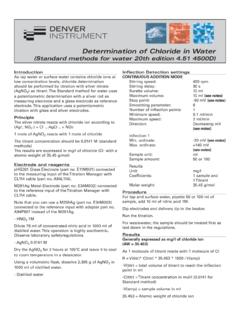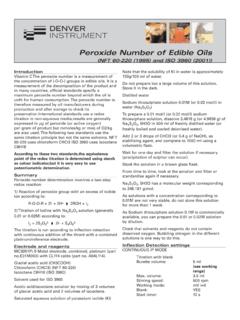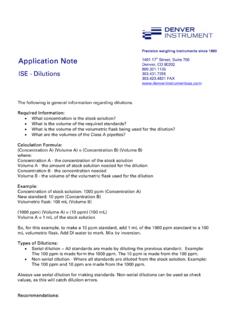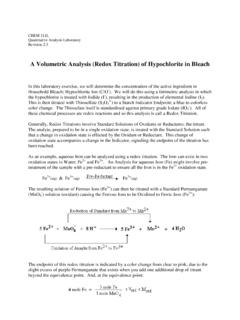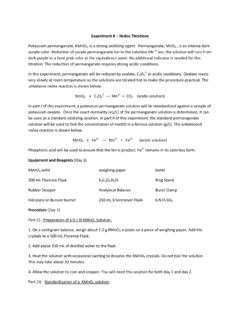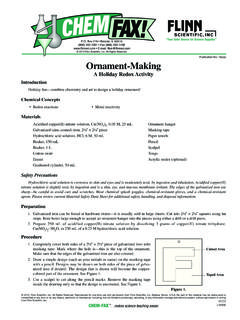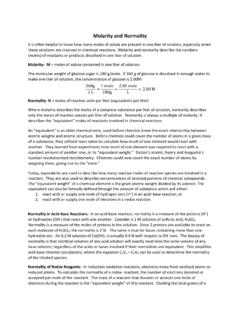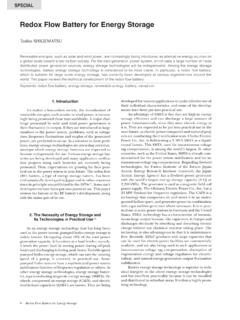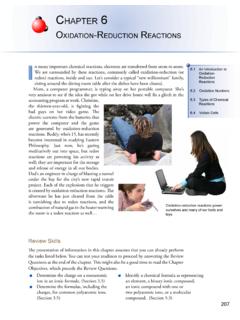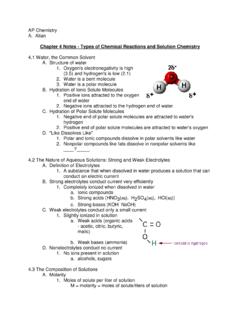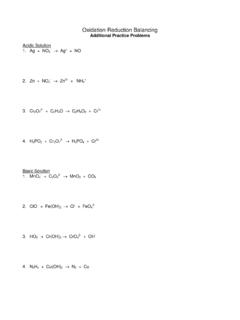Transcription of Bromine Number of Petroleum Products - denver instrument
1 IntroductionThis method covers Bromine Number determination ofcertain Petroleum Products indicated in ASTM standardD1159-98. The magnitude of the Bromine Number issimply an indication of the Bromine reactiveconstituents, not an indication of the constituents. Thebromine Number mainly indicates the concentration ofdouble bonds present in the as g of Bromine (Br2) able to react with 100g of product, the Bromine Number determination usesthe reaction between a (Br-/BrO3-) solution and thepetroleum product according to the following reactionsa) 5 Br- + BrO3 - + 6H+ .. 3Br2 + 3H2Ob) Br2+ R-C=C-R R-C-C-R| |Br-Br(main reaction with product)(Note that other reactions can occur such as addition,substitution or oxidation)To avoid secondary reactions the titration is run at lowtemperature (close to 5 C).
2 The titrant concentration, expressed as Br2concentration, is mol/l (or mol/l). According toreaction (a), the titrant contains 5/12 mole of KBr and1/12 mol/l of molar weight of KBr is and for g/mol. Titration is runaccording to an inflection determination with imposedcurrent potentiometry and a double platinum and reagentsM241Pt2-8 Metal Electrode, double platinum (part ) or M231Pt2 Metal Electrode, doubleplatinum (part no. E32M001) with adapter part T201 Temperature sensor (part no. E51M001)Water-jacketed titration beaker connected to a lowtemperature thermostat or a bath filled with iceBromide-Bromate titrant solution ( mol/l asbromine concentration)Dissolve g of KBr (5* ) and g ofKBrO3 ( ) in 1000 ml of distilled water usinga volumetric acid (1+5)Carefully mix one volume of concentrated sulphuricacid with 5 volumes of distilled water.
3 Caution: thedilution reaction is solvent (see notes)Mix 714 ml of glacial acetic acid (CH3 COOH), 134 ml ofdichloromethane (CH2Cl2), 134 ml of methanol (CH3OH)and 18 ml of sulphuric acid (1+5).Dichloromethane (CH2Cl2)Warning:Reagents used in this application note areflammable. They can cause severe burns and arehazardous if swallowed, breathed or come into contactwith the skin or eyes. Always respect laboratory healthand safety regulations when using these Detection settingsCONTINUOUS IPTitration with blankBurette volume: 10 ml (see notes)Max. volume:7 mlStirring speed: 500 rpmWorking mode:mV with i >0 Current:DCCurrent value: 5 A (see notes)Blank: YESS tart timer: 30 sStop point: 0 mVMinimum ml/minMaximum speed: ml/minSmoothing param: 8 Titration: Decreasing potentialInflection Number : 1 Stop at last IP: YESI nflection 1:Min.
4 Ordinate: 200 mVMax. ordinate: 800 mVSampleDilution: YESS ample unit: gSample amount: 2(see working range)Final dilution vol.: 50 mlAliquot: 5 ml(see working range) Bromine Number of Petroleum Products (ASTM D1159-98 Electrometric titration)Result 1: mlEquation 1:Equation Unit: Bromine numberEquation: (R1*CT* *DA/(SA*AL)(see notes)ProcedureConnect the double platinum wire electrode to thecorresponding input of the Titration the temperature sensor to the correspondinginput on the Titration a new titration solvent batch run a BLANK titrationwith 115 ml of titration solvent and 5 ml ofdichloromethane.)
5 The experimental blank volume isgenerally lower than preparationPlace 10 ml of dichloromethane in a 50 ml volumetricflask then add the weighed sample and fill the flask tothe mark with 110 ml of titration solvent to the titration an aliquot (generally 5 ml but not more than 10ml) of the sample solution in the electrode, temperature sensor and delivery tipin the beaker and immerse the beaker in an ice bath oralternatively in a low temperature thermostatic the electrode direct measurement function of theTitration Manager (icon ELECTRODES and"DISPLAY MEASUREMENT) allow the solution to reachthe mentioned temperature (around 5 C) (see notes).
6 Run the indicated above, results are expressed in g of Br2able to react with 100 g of ( Bromine Number ) =(Vtitr- Vblk)*C(titr)* *100/ W(smp)*1000 Vtitr = Total volume of titrant used in mlVblk = Blank volume used for solvent titrationC (titr) = Concentration of titrant in mol/lW (smp) = Sample weight in = molecular weight of Br2100 = conversion factor for 100 g of product1000 = correction factor for result in g instead of mgFor 5 determinations on cyclohexene (C6H10)Mean delivered mlRel. standard deviation: Bromine Number : 193 Theoretical: rangeFor a sample amount of 1g, and a calculated dilutioncoefficient of 10 (50 ml for final dilution volume and5 ml for the aliquot), 1 ml of mol/l titrantcorresponds to a Bromine Number of magnitude of the Bromine Number of a sample isoften unknown and it is necessary to perform apreliminary test with 2 g of Standard D1159 gives a table for sample amountas a function of Bromine Number :NotesNotes regarding the titration solvent ASTM Standard D1159 gives trichloroethane as analternative for dichloromethane.
7 However, the use ofthis solvent is forbidden in many countries. To savetime, you can store the titration solvent in arefrigerator between the regarding the maximum volumeTo avoid a two-phase system during titration, it is notrecommended to use a titrant volume higher than regarding the imposed currentA 1 A imposed current can give noisy curves and 10 A gives a curve that is not well defined around theinflection point. Instead of DC imposed current it ispossible to use AC imposed current. A 25 A ACimposed current gives titration curves similar to thoseobtained with 5 A DC current. In this case, alsomodify the "Br- Nb-Ctrl-Temp" regarding the equationThe entered equation takes into account theprogrammed dilution of the sample.
8 DA is the finaldilution volume and AL the aliquot regarding sample handlingFor sample and dichloromethane handling, you canuse a glass syringe instead of a regarding temperature measurementAs indicated previously, you can use the DISPLAYMEASUREMENT function, but in this case you canjust check the temperature of the solution (DISPLAYMEASUREMENT checks the measured potential onE1 and E2 inputs, not on Pt-Pt input). You can use thisinformation in the pre-programmed method "Br- Nb-Ctrl-Temp" that measures the potential of the doubleplatinum wire electrode AND the sample regarding the curve shapeBased on experience, the starting potential may bearound 1300 mV and suddenly falls to around 800 mVBromine number0-1010-2020-5050-100100-150150-200 Sample amount in volume in mlAround 4 Around 3-4 Around 5 Around 4 Around 3-4 Around 3-4at the beginning of the titration.
9 Then the curve fallsvery quickly to the final measured potential (generallyaround 100 mV) near the inflection
